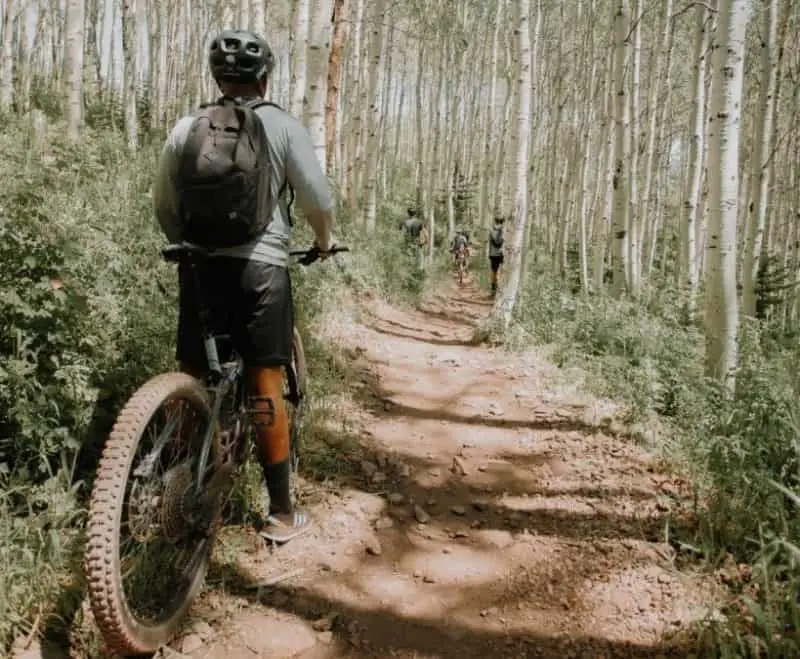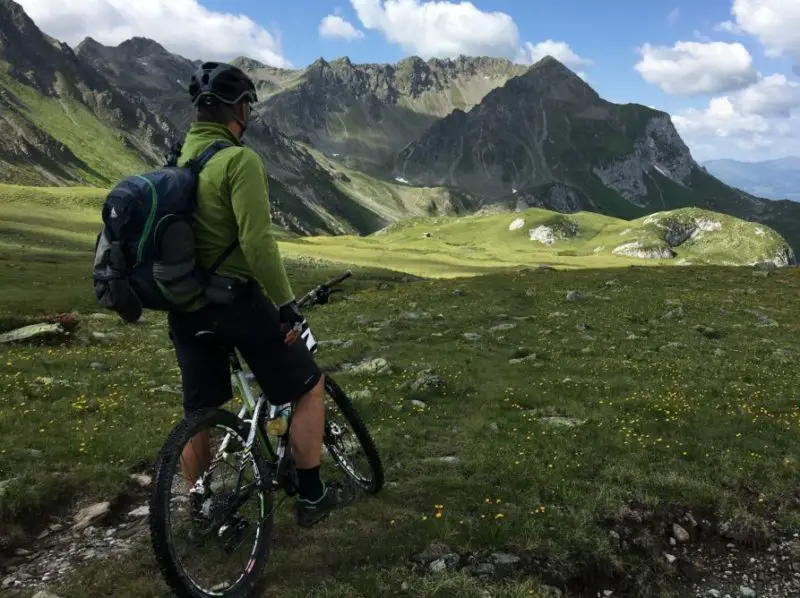Your road cyclist friends may like to brag about those 80 mile rides they do three times a week…while you only managed a few miles on your mountain bike this week.
Feeling inferior about it? Don’t! Distance is no way to compare these two very different riding styles! But how much ground does the average mountain biker cover on a regular basis?
Most mountain bikers complete two 1-2 hour rides per week and log an average of 10 miles, according to rider polls from Singletracks and Pinkbike (two leading sources of mountain bike info). However, this is heavily dependent on many factors, especially the experience level and riding discipline of the cyclist.
Let’s take a look at some of those factors below, so you can get an idea of whether your riding is on par with your ability level…or whether you need to step it up a bit so you don’t get left in the dust!
Average Mountain Bike Ride Times and Distances

Beginner
As a beginner, your main focus should be having fun. Well, also skill building…but mainly fun!
Do you know what’s not fun? Spending so many hours in the saddle that your legs and lungs are on fire and your butt hurts (not sure which is worse!)
USA Cycling Performance Director Marc Gullickson says that for the first 4-6 weeks, beginners should limit riding sessions to 1-2 hours at a time. Beginners need this time to build a base of strength and endurance before pushing themselves any harder, or else they could negatively affect their ability to recover.
Trails can also be kinda scary as a beginner! Though this will decrease the distance you’ll cover during a ride, don’t be afraid to take things slowly, get off the bike and look at any feature you want to ride before attempting it. This is a smart thing to do no matter your experience level!
As a beginner, don’t concern yourself too much with how many miles you ride each session, but rather focus on how your skills are improving. And don’t forget to have fun! When the fun runs out, it’s time to head back to the car and come back another day.
Intermediate
As your skills and endurance improve, you’ll find you’re able to handle longer duration rides. An intermediate rider will regularly spend 2-4 hours on the trails in any one session. With proper training, you’ll be able to push yourself harder without burning out.
Of course, this isn’t 2-4 hours of all out riding! Make sure to incorporate rest periods into your sessions as well. You should stop every once in a while to catch your breath, and replenish your carbohydrates every hour–with those wonderfully gross-looking energy gel pouches, or my personal favorite, Honey Stinger Waffles!
As you improve, you’ll find you’re able to ride your favorite trails faster, and sustain a quicker pace overall. This will allow you to cover more ground over a given time period than a beginner. An intermediate rider will probably be around that 10 mile per week average as reported in the rider poll above.
Advanced
Now that you’re getting better, it’s time to plan an all-day epic ride! You load your gear into the car at sunrise, and don’t come back until the sun starts getting low in the sky. If you’re considering a mountain bike-specific vacation, you’re probably in store for some epic rides!
Advanced riders routinely tackle 4-5 hour sessions or more. With an epic ride, you have to make sure you account for the time you’ll spend riding to the trailhead. This is often a pretty significant distance on flat roads (if you’re lucky) or sustained climbs (if you’re not). You could be in for a long pedal before you even reach your first fun trail!
An epic ride will often cover a greater distance – at least 10 miles – but this isn’t always the case. While an advanced cross-country rider could easily log 20 miles or more in one session, another rider could spend all day in a bike park (where you ride a chair lift to the top of the mountain) and barely ride more than a few miles.
Riding discipline has a huge impact on the distances covered by riders of any experience level, so it’s wise to take that into account when trying to determine how you stack up to the averages listed here.
4 Factors that Slow Down Mountain Bike Rides

1. Climate
It’s the beginning of summer here in Florida, which means it’s 90 degrees by 9am with 101% humidity all day. Even though I’m on the road before the sun comes up, my rides get a lot shorter this time of year because it’s just so…dang… hot!!!
The same can be said for any climate extreme: when it’s cold, your body tends to slow down, inhibiting your response time; when it’s rainy, the trails get slippery and you’ll need to take extra time to make it up or down safely; when it’s snowing…well maybe you should take up skiing instead.
Factor extra time into your rides when the weather conditions are less than ideal. There’s no point in trying to best your old times if it means riding unsafely for the given trail conditions!
2. Trail Type
In general, trails can be divided into two categories: flowy or technical. Flow trails are usually smooth and fast, while tech trails require some extra thinking–and proper line choice–to complete.
Tech trails can feature challenging climbs, rooty sections, rock rolls (no, not Rick-rolls…those are worse), tight switchbacks and other difficult features that take time to examine, plan and clean without dabbing–or needing to put your foot down on the trail because you lost your balance…the ultimate embarrassment your riding buddies will be sure to remember.
I love the challenge of a good technical trail, but I always know it will slow me down. But they’re fun and make you a better rider, so don’t be afraid to try them!
3. Sessioning
Sessioning is attempting an especially interesting–aka fun or difficult–section of a trail repeatedly until you clean it for the first time or do it better than you have before.
This is probably the factor that slows me down the most, especially if I’m riding with friends. If you’re in a group and you roll up to a challenging feature – say, a super rocky climb or descent – competition ensues. Everyone is vying to become the first person in the group to complete it successfully…but the session doesn’t end until everyone cleans it.
Sometimes sessioning attracts a crowd of people who also want to get in on the action. I’ve spent over an hour on one trail section before, just talking to new people and having fun. It’s well worth the extra time, and you’ll learn a lot from watching other, better riders!
4. Bike Park Lift Lines
Oh, you thought you could maximize your time and avoid long, boring climbs by going to a bike park and taking a chairlift to the top of the mountain?? Think again!
Bike parks are great for helping you save energy for the fun downhill stuff, but at the peak of riding season, they’re as crowded as theme parks: you might find yourself waiting in line for more than an hour behind a sea of other riders all shuffling slowly toward the lift.
Luckily I’ve never had to deal with this (I go to bike parks in the off-season!) but I can imagine how frustrating it would be to bomb some sweet downhill trails for about 10 minutes…only to spend the next 60 waiting for a ride back to the top to do it again.
This is also why I NEVER go to theme parks…you pay super high prices, wait in line forever, and don’t even get to ride bikes at the end! Lame.
Average Mountain Bike Speed
Average riding speed is greatly influenced by your ability level, but also by your riding discipline, so it’s really hard to provide a generalized answer here.
As a rule of thumb, the more experienced you become, the faster you’ll be able to go on any type of trail. However, some riding disciplines obviously lend themselves to faster speeds. A downhill rider may often reach speeds of 40mph or more, while someone picking a careful line up a steep, rocky climb would be lucky to see the speedometer move past 1mph.
For most singletrack riding, your average speed will probably be somewhere just north of the single digits.
Ride Farther, Ride Faster, Ride Better!
Speed and distance should not be the only metrics you’re chasing. Look at your riding holistically: are your skills improving? Are you able to clean trail features you never have before?
You may not always be going faster or riding longer, but you’re probably getting better in some aspect of your riding every time. Don’t forget to notice and celebrate those small victories!
